 |
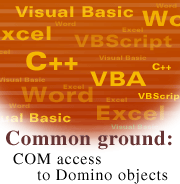
by
Robert
Perron

 

Level: Advanced
Works with: Designer 5.0
Updated: 01/10/2000

Inside this article:
Getting started in Visual Basic
Initializing a Domino session
Getting started in VBScript
Working through the object hierarchy
Opening and creating databases
Getting item values
Working with constants and error codes
Porting between Visual Basic and LotusScript

Related links:
Microsoft COM home page
QMR/QMU Incremental Installers
Documentation Library
Lotus Developer Network Technology and Toolkits Zone
Sidebar: Common paths to Domino objects

Get the PDF:
 (435 KB) (435 KB)


|  |
Visual Basic and other programmers working outside Domino and Notes have for many years accessed the Domino objects through OLE (Object Linking and Embedding). But OLE:
- Requires the presence of the Notes client on the accessing machine, and Notes must be running. If Notes is not running at the time of OLE access, it is launched for you as a separate process.
- Supports only late binding. Objects are generic and cannot be typed for compile-time checking and browser lookup.
Now -- as of release 5.0.2b -- the Domino objects are accessible through the Component Object Model (COM) with these benefits:
- COM requires the presence of Domino or Notes but the software can be Domino server, Domino Designer, or Notes client.
- The Domino or Notes software does not have to be running.
- Supported are both early (compile-time) and late (run-time) binding.
You can download the 5.0.2b QMU from the QMR and QMU Incremental Installers page on Notes.net.
The Domino objects consist of the back-end classes available through LotusScript and Java. For the front-end classes -- NotesTimer, NotesUIDatabase, NotesUIDocument, NotesUIView, and NotesUIWorkspace -- you still need OLE and a running Notes client.
The examples in this article are in Visual Basic (early binding) and VBScript (late binding). However, you can access the Domino objects from any language or application interface that supports COM, including C++, VBA in Word and Excel, and VBScript in ASP.
Getting additional information
The Domino Designer documentation will be updated for release 5.0.3 to include COM information. When it is available, see the topic "Accessing the Domino objects through COM" in the updated Domino 5 Designer Help database. In the index, look for "COM." In the contents, scroll through the LotusScript/COM/OLE topics. The new help database will be posted in the Documentation Library on Notes.net and will be available in the release 5.0.3 software kits.
The Lotus Domino and Notes Toolkit for COM is available for download from the Lotus Developer Network Technology and Toolkits Zone. The toolkit contains sample code, the COM support files, and documentation. The code examples are in C++, Visual Basic, VBA in Word and Excel, and VBScript in ASP.
Installation and registration
After installing release 5.0.2b, you will see in the operating system registry a class named Lotus.NotesSession, as shown below. This is the root of the Domino COM classes. Still present are Notes.NotesSession and Notes.NotesUIWorkspace which are the OLE roots.
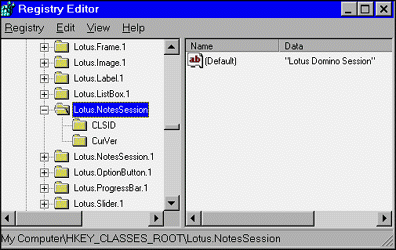
Getting started in Visual Basic
In Visual Basic, create or open a project and choose Project - References:
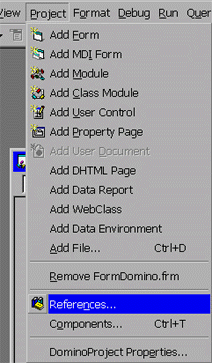
Scroll down and check "Lotus Domino Objects":
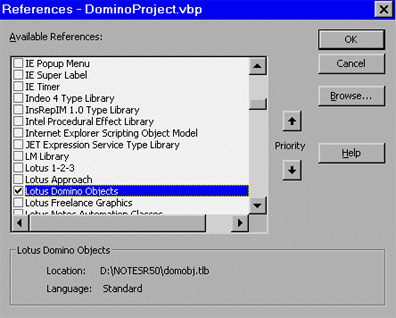
The Domino objects then become available to the project. You can access them through the object browser.
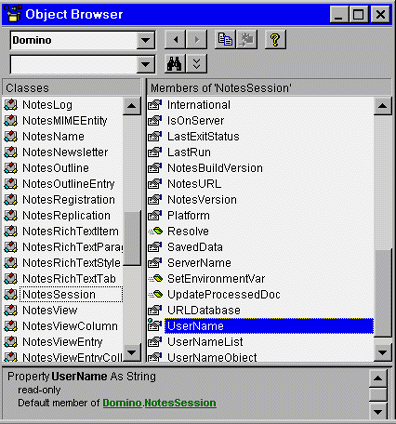
You can access them from a drop-down menu that becomes available after you type the name of an object and a period.
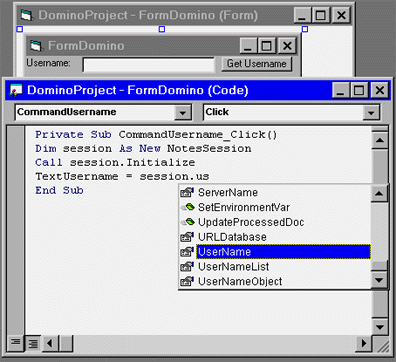
Initializing a Domino session
Create the root NotesSession object with Dim New or CreateObject. Then initialize the session with one of the COM-only NotesSession methods Initialize or InitializeUsingNotesUserName. A COM session requires explicit initialization, which is not the case in LotusScript.
The following Sub shows the minimum code needed to access the Domino objects. The code shows both techniques for creating the NotesSession object, the Dim New technique being commented out.
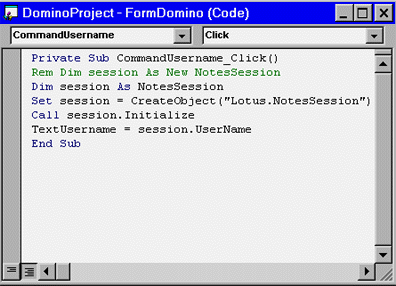
The Initialize method shown in the code bases the session on the current Domino or Notes user ID. If the user ID requires a password, a prompt appears at run-time. Optionally you can specify the password in the code:
Call session.Initialize("UserIDPassword")
If the machine contains both server and client software, the user ID depends on which software is current in the operating system registry.
If the code is running on a machine containing a Domino server, you can base the session on a user name in the local Domino Directory with:
Call session.InitializeUsingNotesUserName("UserName")
An empty string means "Anonymous." Access depends on the "Server Access" and "Java/COM Restrictions" settings in the user record in the Domino Directory.
In this case, the password is the Internet password in the user record in the Domino Directory. If a password is required and you do not want prompting or the software (for example, VBScript under ASP/IIS) does not support prompting, specify a second parameter:
Call session.InitializeUsingNotesUserName("UserName", "InternetPassword")
Getting started in VBScript
Only late binding is available in VBScript. The language precludes data typing and compile-time checks. You must use CreateObject to create the NotesSession object. The following example shows the source code from an HTML file being run by Internet Explorer. The example was created using a simple text editor.
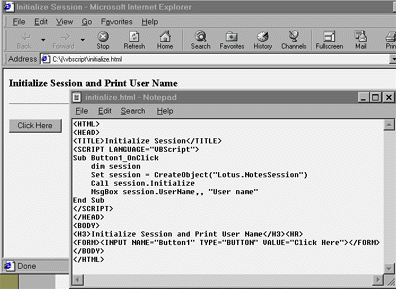
Working through the object hierarchy
NotesSession is the only Domino object you can create directly. You obtain other Domino objects by calling properties and methods in NotesSession that return them and working down through the hierarchy. For example, various methods in NotesSession beginning with "Create" return Domino objects, as shown below:
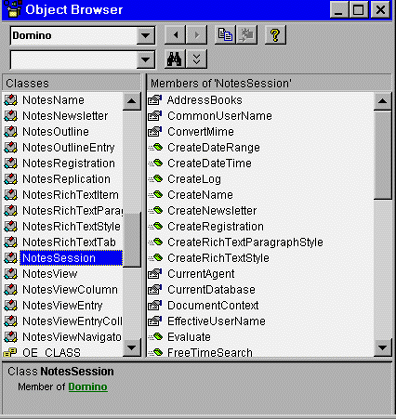
The CurrentAgent, CurrentDatabase, and DocumentContext properties you see in the object browser are not implemented. Neither are the UnprocessedDocuments property, UnprocessedFTSearch method, and UnprocessedSearch methods in NotesDatabase. They compile without error but fail at run-time. At this time, the COM objects do not have the concept of a current environment.
See the Common paths sidebar for common paths to Domino objects. Note that the information in the sidebar shows typically used paths and is not comprehensive.
Opening and creating databases
GetDatabase in NotesSession opens a database if it exists. You supply the server name (an empty string means the local Domino or Notes data directory) and file name of the database. Use IsOpen to make sure you have a database because GetDatabase does not return an error if the database does not exist. These procedures are the same as in LotusScript.
This example opens NAMES.NSF on the server Snapper and displays the title of the database:
Private Sub GetNames_Click()
Dim session As New NotesSession
session.Initialize
Dim db As NotesDatabase
Set db = session.GetDatabase("Snapper", "names")
If db.IsOpen Then
MsgBox db.Title, , "Title of names.nsf"
Else
MsgBox "File does not exist", , "Title of names.nsf"
End If
End Sub
You can access a Domino or Notes directory and its constituent databases through GetDbDirectory in NotesSession. The following example is functionally the same as the preceding.
Private Sub GetNames2_Click()
Dim session As New NotesSession
Dim dir As NotesDbDirectory
Dim db As NotesDatabase
session.Initialize
Set dir = session.GetDbDirectory("Snapper")
Set db = dir.OpenDatabase("names")
If db.IsOpen Then
MsgBox db.Title, , "Title of names.nsf"
Else
MsgBox "File does not exist", , "Title of names.nsf"
End If
End Sub
The methods that create and open databases differ in containment between COM and LotusScript. In COM, you perform the create or open function with a NotesDbDirectory method; in LotusScript, you create a NotesDatabase object with New then use a NotesDatabase object to perform the function. You must rewrite this code when porting between COM and LotusScript. The specific differences are as follows:
| COM: NotesDbDirectory | LotusScript: NotesDatabase |
| CreateDatabase | Create |
| OpenDatabase | Open (with parameters) |
| OpenDatabaseByReplicaID | OpenByReplicaID |
| OpenDatabaseIfModified | OpenIfModified |
| OpenMailDatabase | OpenMail |
NotesDatabase.Open without parameters is the same in COM and LotusScript.
The navigation methods of NotesDbDirectory are the same in COM and LotusScript with two caveats. In early-binding COM code, do not use the constant DATABASE to avoid a naming conflict; use NOTES_DATABASE instead. In late-binding COM code, the constants are not available and you must specify their integer values: 1245 (REPLICA_CANDIDATE), 1246 (TEMPLATE_CANDIDATE), 1247 (NOTES_DATABASE), and 1248 (TEMPLATE).
The following Visual Basic code loops through the local Domino or Notes directory:
Private Sub LoopDbDirectory_Click()
Dim session As New NotesSession
Dim dir As NotesDbDirectory
Dim db As NotesDatabase
session.Initialize
Set dir = session.GetDbDirectory("")
Set db = dir.GetFirstDatabase(NOTES_DATABASE)
While Not (db Is Nothing)
MsgBox db.Title, , db.FilePath
Set db = dir.GetNextDatabase
Wend
End Sub
In VBScript, the coding is as follows:
<HTML>
<HEAD>
<TITLE>Initialize Session</TITLE>
<SCRIPT LANGUAGE="VBScript">
Sub Button1_OnClick
dim s, dir, db
Set s = CreateObject("Lotus.NotesSession")
Call s.Initialize
Set dir = s.GetDbDirectory("")
Set db = dir.GetFirstDatabase(1247)
While Not (db Is Nothing)
Msgbox db.Title,, db.Filepath
Set db = dir.GetNextDatabase
Wend
End Sub
</SCRIPT>
</HEAD>
<BODY>
<H3>Loop through local Notes directory</H3><HR>
<FORM><INPUT NAME="Button1" TYPE="BUTTON" VALUE="Click Here"></FORM>
</BODY>
</HTML>
Getting item values
In COM, you cannot use the shorthand that permits specification of an item name as a NotesDocument property. The following code, for example, cannot be ported from LotusScript to COM:
Dim doc as NotesDocument
...
Msgbox doc.Subject(0),, "Contents of Subject item"
To access item values, you must use AppendItemValue, GetItemValue, or ReplaceItemValue in NotesDocument, or Values in NotesItem.
The following example gets the values of the Subject and Categories items in each document in a local database. As in LotusScript, text, numeric, and date values are returned in an array. To access a single-value item, such as Subject, access the first element. To access a multi-value item, access all the elements or all the desired elements.
Private Sub GetSubjects_Click()
Dim session As New NotesSession
Dim db As NotesDatabase
Dim dc As NotesDocumentCollection
Dim doc As NotesDocument
session.Initialize
Set db = session.GetDatabase("", "document examples")
If Not db.IsOpen Then
MsgBox "File does not exist", , "document examples"
Exit Sub
End If
Set dc = db.AllDocuments
Set doc = dc.GetFirstDocument
While Not (doc Is Nothing)
catmsg = "Categories:"
REM Get all values in Categories item
For Each cat In doc.GetItemValue("Categories")
catmsg = catmsg & Chr(10) & " " & cat
Next
REM Get first (and only) value in Subject item
MsgBox catmsg, , doc.GetItemValue("Subject")(0)
Set doc = dc.GetNextDocument(doc)
Wend
End Sub
Notice that in COM the loop structure is "For Each" and "Next," while in LotusScript it is "ForAll" and "End ForAll." This syntax must be changed manually when porting.
The next example creates a document and uses AppendItemValue to add Subject and Categories items.
Private Sub CreateDocument_Click()
Dim session As New NotesSession
session.Initialize
Dim db As NotesDatabase
Set db = session.GetDatabase("", "document examples")
If Not db.IsOpen Then
MsgBox "File does not exist", , "document examples"
Exit Sub
End If
Dim doc As NotesDocument
Set doc = db.CreateDocument()
doc.AppendItemValue "Subject", "New Document"
Dim cats(2) As String
cats(0) = "Category One"
cats(1) = "Category Two"
doc.AppendItemValue "Categories", cats
doc.Save False, False
End Sub
Working with constants and error codes
In Visual Basic, constants are available through the object browser. You can access them through Enum structures listed in all uppercase in the left-hand pane or through <globals> in the left-hand pane. Demonstrated below is the Enum structure for DB_TYPES. As noted previously, use NOTES_DATABASE, not DATABASE.
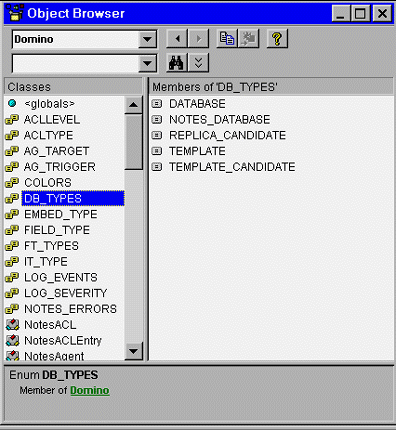
The error constants are listed under NOTES_ERRORS.
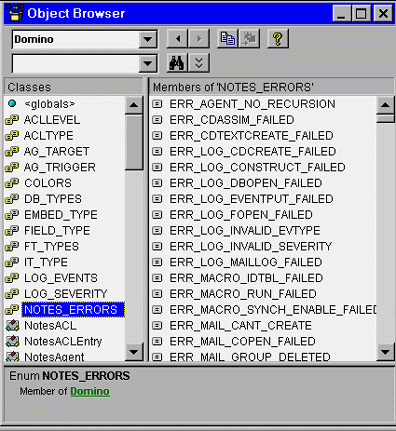
The following code tests for the specific Domino error ERR_SYS_FILE_NOT_FOUND. If this is not the error, the code derives the Domino error code from the error number returned by the Err() intrinsic function. In COM, the error number is four bytes: the first two bytes are hexadecimal 8004; the last two bytes are the Domino error code. The sample code takes the last four hexadecimal digits of the error number and converts them to an integer.
Private Sub ErrorTest_Click()
On Error GoTo ErrorHandler
Dim session As New NotesSession
session.Initialize
Dim db As NotesDatabase
Set db = session.GetDatabase("", "fooey")
db.Open
MsgBox db.Title, , "Title of fooey"
Exit Sub
ErrorHandler:
If Err() = ERR_SYS_FILE_NOT_FOUND Then
MsgBox "File not found", , "Domino Error"
Else
MsgBox CInt("&H" & Right(Hex(Err()), 4)), , "Domino Error"
End If
End Sub
LotusScript does not currently support the Err intrinsic object. In COM, however, you could use Err.Number instead of Err(), for example:
If Err.Number = ERR_SYS_FILE_NOT_FOUND Then
In VBScript, you must use Err.Number because VBScript does not support the Err() intrinsic function.
In late binding languages such as VBScript, you do not have use of the named constants. You must specify the actual integer values. Use the following resources to find these values:
- In Domino 5.0.3 Designer Help, reference the topic "Accessing the Domino objects through COM" and "Handling run-time errors" in the contents under LotusScript/COM/OLE, or look up "COM" and "Error handling" in the index.
- Look up the error constants in the LSXBEERR.LSS file in the Domino or Notes program directory.
- Interrogate DOMOBJ.TLB in the Domino or Notes program directory with a tool such as Visual InterDev (VID).
- If you have Domino Designer or Visual Basic, display the value of a constant (for example, with MsgBox) or look it up in the object browser.
The following code is a VBScript implementation of the preceding example. The code defines a variable with the name and value of the error to be checked. The error value is constructed by appending the hexadecimal form of the Domino error code to hexadecimal 80040 (if the error code is three digits) or 8004 (if the error code is four digits), and converting the resulting 8-digit hexadecimal value to a long value. (Since the error code is a constant, the conditional logic is unnecessary. It is included for demonstration purposes.)
<HTML>
<HEAD>
<TITLE>Initialize Session</TITLE>
<SCRIPT LANGUAGE="VBScript">
Sub Button1_OnClick
On Error Resume Next
dim s, db, ERR_SYS_FILE_NOT_FOUND
If Len(Hex(4003)) = 3 Then
ERR_SYS_FILE_NOT_FOUND = Clng("&H80040" & Hex(4003))
Else
ERR_SYS_FILE_NOT_FOUND = Clng("&H8004" & Hex(4003))
End If
Set s = CreateObject("Lotus.NotesSession")
Call s.Initialize
Set db = s.GetDatabase("", "fooey")
db.Open
If Err.Number = 0 Then
MsgBox db.Title,, "Title"
Else
If Err.Number = ERR_SYS_FILE_NOT_FOUND Then
MsgBox "File not found",, _
"Domino Error"
Else
MsgBox CInt("&H" & Right(Hex(Err.Number), 4)),, "Domino Error"
End If
End If
End Sub
</SCRIPT>
</HEAD>
<BODY>
<H3>Get fooey.nsf</H3><HR>
<FORM>
<INPUT NAME="Button1" TYPE="BUTTON" VALUE="Click Here">
</FORM>
</BODY>
</HTML>
Porting between Visual Basic and LotusScript
Many of the porting adjustments have been mentioned already. To reiterate:
- Only the back-end classes are available to COM. The NotesUI classes and NotesTimer are not.
- You must initialize a COM session. The NotesSession methods to do this are Initialize("UserIDPasswordOptional") and InitializeUsingNotesUserName("UserName", "InternetPasswordOptional").
- You cannot create a Domino object directly except for NotesSession. You must work down through the Domino Objects hierarchy using methods and properties that return those objects.
- COM has no notion of a current environment. Not implemented are UnprocessedDocuments, UnprocessedFTSearch, and UnprocessedSearch in NotesDatabase, and CurrentAgent, CurrentDatabase, and DocumentContext in NotesSession.
- COM uses the NotesDbDirectory methods CreateDatabase, OpenDatabase, OpenDatabaseByReplicaID, OpenDatabaseIfModified, and OpenMailDatabase to create and open databases. In LotusScript, you create new NotesDatabase objects and use the NotesDatabase methods Create, Open, OpenByReplicaID, OpenIfModified, and OpenMail.
- In COM, you cannot treat an item name as a NotesDatabase property. Access items with AppendItemValue, GetItemValue, and ReplaceItemValue in NotesDatabase, and Values in NotesItem.
- Visual Basic uses For Each ... Next loops. LotusScript uses ForAll ... End ForAll loops.
- Constants port both ways as long the Enum structure is not specified in COM. For example, the constant NOTES_DATABASE (value of 1247) can be specified as DATA_TYPES.NOTES_DATABASE in COM but won't port back to LotusScript that way. Be sure to use NOTES_DATABASE and not DATABASE.
- LotusScript does not support the Err intrinsic object. Both LotusScript and Visual Basic support the Err() intrinsic function. (VBScript does not support the Err() intrinsic function.)
The COM classes contain additional properties and methods for purposes of utility. These properties and methods will probably be incorporated in LotusScript in future releases but are not planned for release 5.0.3. They include:
- HttpURL and NotesURL for returning the accessing URL in NotesAgent, NotesDatabase, NotesDocument, NotesForm, NotesSession, and NotesView.
- Parent for getting a handle to the containing object in NotesDateRange, NotesDateTime, NotesDbDirectory, NotesForm, NotesInternational, NotesLog, NotesName, NotesNewsletter, NotesOutlineEntry, NotesRichTextStyle, and NotesViewColumn. Also ParentDatabase in NotesOutline.
- In NotesSession: ServerName, URLDatabase, UserNameObject, CreateRegistration, Evaluate, and Resolve.
- In NotesView, CreateViewNavMaxLevel and GetColumn.
- In NotesViewNavigator: GetCurrent, GotoChild, GotoEntry, GotoFirst, GotoFirstDocument, GotoLast, GotoLastDocument, GotoNext, GotoNextCategory, GotoNextDocument, GotoNextSibling, GotoParent, GotoPos, GotoPrev, GotoPrevCategory, GotoPrevDocument, and GotoPrevSibling.
LotusScript does not support the Boolean data type. The Domino LotusScript classes type boolean-style parameters and return values as Integer or Variant. This is not a problem porting from LotusScript to Visual Basic. However, data typed as Boolean in Visual Basic cannot be ported without modification to LotusScript.
Other more minor differences exist between the COM and LotusScript classes, and between the Visual Basic and LotusScript languages. These are enumerated in the updated Domino 5 Designer Help for release 5.0.3.
In conclusion
You can now access the back-end Domino objects from any software that supports COM. The only requirement is installation of Domino server, Domino Designer, or Notes client release 5.0.2b (or later) on the machine using COM. The Domino or Notes software need not be running.
This article provided examples in the early-binding Visual Basic and late-binding VBScript. For examples in C++, Visual Basic, VBA in Word and Excel, and VBScript in ASP, plus documentation, you can download the Lotus Domino and Notes Toolkit for COM from the Lotus Developer Network Technology and Toolkits Zone.
ABOUT THE AUTHOR
Robert Perron is a Documentation Architect with Lotus in Westford, Massachusetts. He has developed documentation for Lotus Notes and Domino for over five years with a primary concentration on programmability. He developed the documentation for the LotusScript and Java Notes classes and coauthored the book 60 Minute Guide to LotusScript 3 - Programming for Notes 4. |